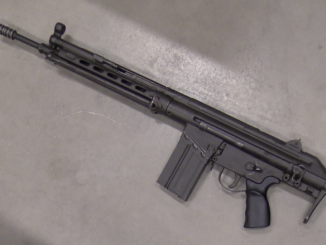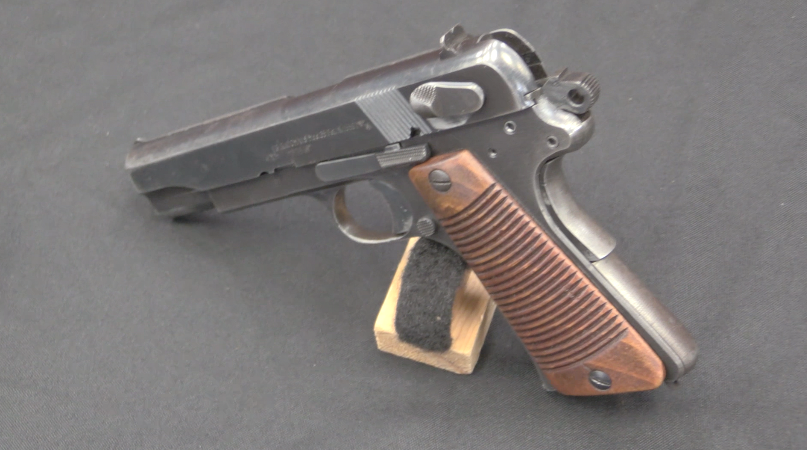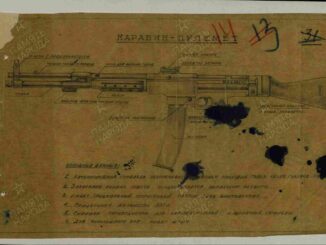The Colt Woodsman, introduced in 1915, was the premier – and really the only serious – option for the competitive target shooter into the 1920s when the Walther company decided to introduce a competitor. Walther needed a product to bring business, of course, and the Versailles treaty prohibited it from manufacturing military arms. So, with the flexibility and responsiveness that the company often exhibited, it decided to enter the competition pistol market in 1925 with the Olympia.
This was a semiautomatic, .22 Long Rifle caliber pistol with a 10-round magazine. It was a simple blowback action, with large precise sights and a quite nice feel to the grip. It was not quite the equal of the Woodsman in international competition, but still a strong second-place contender on the market.
Always looking to improve and respond to customer desires, Walther began to experiment with changes to the Olympia in the early 1930s, and in 1936 introduced a brand new version. This new Olympia offered, among other improvements, the option to add barrel weights, and it became an even more serious competitor for the Woodsman.
Today we will be looking at a large selection of Olympias, showing you all the different variations of both the 1925 and 1936 models as well as some transitional guns from Walther’s experimental period.




”
HomeCompetitionWalther Olympia: Germany’s Interwar Target Pistol
Walther Olympia: Germany’s Interwar Target Pistol
February 18, 2018 Ian McCollum Competition, Semiauto pistol, Video 0
The Colt Woodsman, introduced in 1915, was the premier – and really the only serious – option for the competitive target shooter into the 1920s when the Walther company decided to introduce a competitor. Walther needed a product to bring business, of course, and the Versailles treaty prohibited it from manufacturing military arms. So, with the flexibility and responsiveness that the company often exhibited, it decided to enter the competition pistol market in 1925 with the Olympia.”
In Germany there was other .22 Long Rifle automatic pistol produced since 1924 by RÖMERWERKE A.G.SUHL: https://www.ar15.com/forums/equipment-exchange/-/131-590842/?
I found this design more likely reason for WALTHER to developed their .22 Long Rifle automatic pistol
That was time when nobody worried about “barrel over grip height”. All new and artificial problems we invented would be laughed at then.
Keep in mind that at time revolver were still often encountered, so compared to that type of fire-arm, that automatic pistol gave advantage in that regard.
I have a French MAS 22 pistol that is almost a copy of the 26 Walther. It has the same proportions in the 10″ barrel and grip and even has a molded grip made to fit the hand of the shooter.
After WWII, Norinco produced a reverse engineered “Olympia” .22 pistol of their own. It’s actually quite accurate.
Hämmerli in Switzerland produced a “clone” of the Olympia, the Hämmerli Olympic, under license from Walther in the 1950s when Walther was recovering from the loss of their original factory (which was in what became East Germany).
Interestingly, in 2006 Walther bought Hämmerli (which primarily makes air guns today), and licensed the Hämmerli trademark to Umarex USA.
https://en.wikipedia.org/wiki/H%C3%A4mmerli
cheers
eon
These are very well looking pistols and well optimised for their purpose – sport shooting. Little note on design of 22LR magazines; it is not as easy as it looks. I tried one time hard way; it did not work first time. In order to allow for rim intrusion, one way to do it is to make rear portion of tube wider. Who’s got in possession 22cal. pistol take a look at it in detail.
What I meant is to achieve an effect where the shots are vertically aligned in front but in back are partially staggered. Final effect when looking from side is that they are almost parallel. The trick is to find right amount of ‘staggering’ (fanning).
Indeed, making reliable magazine for self-loading or automatic gun for rimmed cartridge is more hard that rimless. In Soviet Union there was in 1942-43 competition for light light machine gun (that is lighter than DP and also cheaper) for 7,62×54 R cartridge, despite many attempt all failed, mainly due to no way to make reliable 20-round magazine for that cartridge, it is described here: https://www.kalashnikov.ru/pulemyotnaya-drama-krasnoj-armii-2/
in Магазин под патрон с закраиной и без — проблемы разработки chapter
Better photos of Горов machine gun:
http://zonwar.ru/news5/news_879_pulemet_Gorova.html
notice combination of gas-operation and quick-change barrel, magazine from Lahti-Saloranta machine gun was used, it was found to be culprit of most fails, designer was unable to made his machine gun work reliably with that magazine, despite some attempts.
As interesting tidbit, that machine gun:
– worked quite as intended, when firing single shots – 1 failure
– has some problem with short-burst (3-5 shots), for 25 cartridges fired – 3 failures
– always fail when long-burst (20 shots) mode was attempted
– failure rate increased when fired in vertical position (AA fire)
Overall mass (without magazine) was 6,5 kg (wooden stock variant), mass of loaded magazine 0,91 kg, overall length 1080 mm (wooden stock variant) or 1330 mm / 895 mm (metal folding stock), barrel length 505 mm, Rate-of-Fire 800 rpm
Very interesting to see past effort to produce alternative mag for DP. On surface it looks like something like ‘simple conversion’ but it is not. When I look at Dragunov’s mag, first thing what hits the eye is how strangely is curved at the entrance into receiver. Yet, SVD is know as not having issues feeding.
“past effort to produce alternative mag for DP”
It is not alternative magazine but whole new machine gun and magazine system.
“on design of 22LR magazines; it is not as easy as it looks. I tried one time hard way; it did not work first time. In order to allow for rim intrusion, one way to do it is to make rear portion of tube wider. ”
As I said before .22 Long Rifle is living fossil for me. I now started wondering which was first mass-produced fire-arm for that cartridge?
Don’t feel bad; very few box-magazine fed .22s ever feed reliably. The most effective magazine tube profile seems to be almost a “keyhole” shape, like an old-time warded lock, with the wide part at the rear.
Another factor is a follower which holds the rounds at an angle that precludes the rim of a round getting caught behind that of the one below it in the tube.
This virtually requires a sharply-“raked” magazine angle to the bore, to allow the bolt to push the round almost straight into the chamber. The single biggest problem with box-magazine .22s is the top round “popping up” and ramming into the breech above the chamber mouth. I have never encountered any such design, whether self-loading or manually-operated, that doesn’t do this on occasion. Some do it at least once in every magazine,the Remington Nylon 77 in its various iterations being a particularly bad offender in this regard.
One of the most reliably-feeding box magazine .22s was the old Whitney automatic pistol. Its combination of magazine structure and angle presented the round to the chamber in almost a straight line, much like a Parabellum in 9 x 19mm. Somehow,in re-creating the Whitney, Olympic Arms has never quite gotten that right.
Honestly, I’ve personally gone off the idea of box-magazine .22s. Give me a tubular magazine rifle (lever-action or pump-action for a preference) or a revolver for a .22 pistol.
Even in the 21st Century, the KISS principle still applies.
cheers
eon
There were some center-fire counterparts to the .22lr that didn’t survive the depression era. One was made by Francotte and others were found in Germany. The problem with those cartridges is that there were no customers during the next war, and the Francotte semi automatic lever-cocked rifles were unpopular in America as they were perceived as inferior to domestic products, especially when the action of the former was modified to be lever action only. Did I mess up?
Yes, you are right… it is like “keyhole” profile; good way to describe it. We had that time (long time back) plastic molded insert fit into standard rifle magazine. So it was not cheap to change the mold. Instead we opened / relieved sides each couple of rounds and it worked eventually. But first I felt a bit embarrassed.
As a matter of fact, I have one 10 rounder for my small-bore which I did not try yet (legal in Canada since it is rimfire as opposed to centerfire). I go right down to my vault to check it out.
You could also use a rotary magazine like Ruger did with the 10/22. Rotary magazines are also used in semi-auto PCP rifles, since there is probably no way to feed pellets reliably from a box magazine.
“rotary magazine like Ruger did with the 10/22”
Still in automatic pistol such magazine of serious capacity would add bulk.
For high-capacity .22 rim-fire I would suggest endless-belt approach, similar in layout to Sosso automatic pistol: https://modernfirearms.net/en/handguns/handguns-en/italy-semi-automatic-pistols/sosso-eng/
In the 1932 Olympics at Los Angeles, German competitor Heinrich Hax (silver medal) decided to switch to a Colt Woodsman, because it could be fired faster. (1932 was the introduction of Olympic Silhouette Shooting, 8 seconds for 6 targets.) In my opinion this is what triggered the development of the Walther as we know it. In 1936, gold (Cornelius van Oyen) and silver (again Heinrich Hax) were the result.
I am observing an interesting grip feature; assuming the pistols are designed for right handed shooter. Instead of relief for trigger finger (as on service pistols) I can see a swell. My understanding it that this was supposed to create condition when only last link of finger would be in engagement. I could go on about the dynamics of this important part but it might be too much of diversion. But for what I know, there is quite a bit to it.
Any Walther pistol is a good one.
http://www.clingerholsters.com
Is this feeding ramp somehow moveable/springloaded.
Looks like it would otherwise come in the way with the rim of the cartridge.
I just came across this article/video today as I searched for information on a Hammerli-Walther Olympia-Pistole. I hope you’re still monitoring replies. I have one of these Serial Number 0-6222 and it’s marked “Lenzberg and Switzerland”. It’s in outstanding condition. I actually have the left and right handed grips for it. I also have at least two of the original magazines and this one has the muzzle brake. How does one go about determining the value of these pistols? There is precious little information online and most of that is pretty general.
walther 1925 opympia 22 caliber pistol magazine we have the pistol but the magazine has been lost we have ordered by serial number but magazine does not fit can you help me
need help ID 1936 olympia can notfind 1 single pic. like it! would love to send you pics serial num. 3044-O